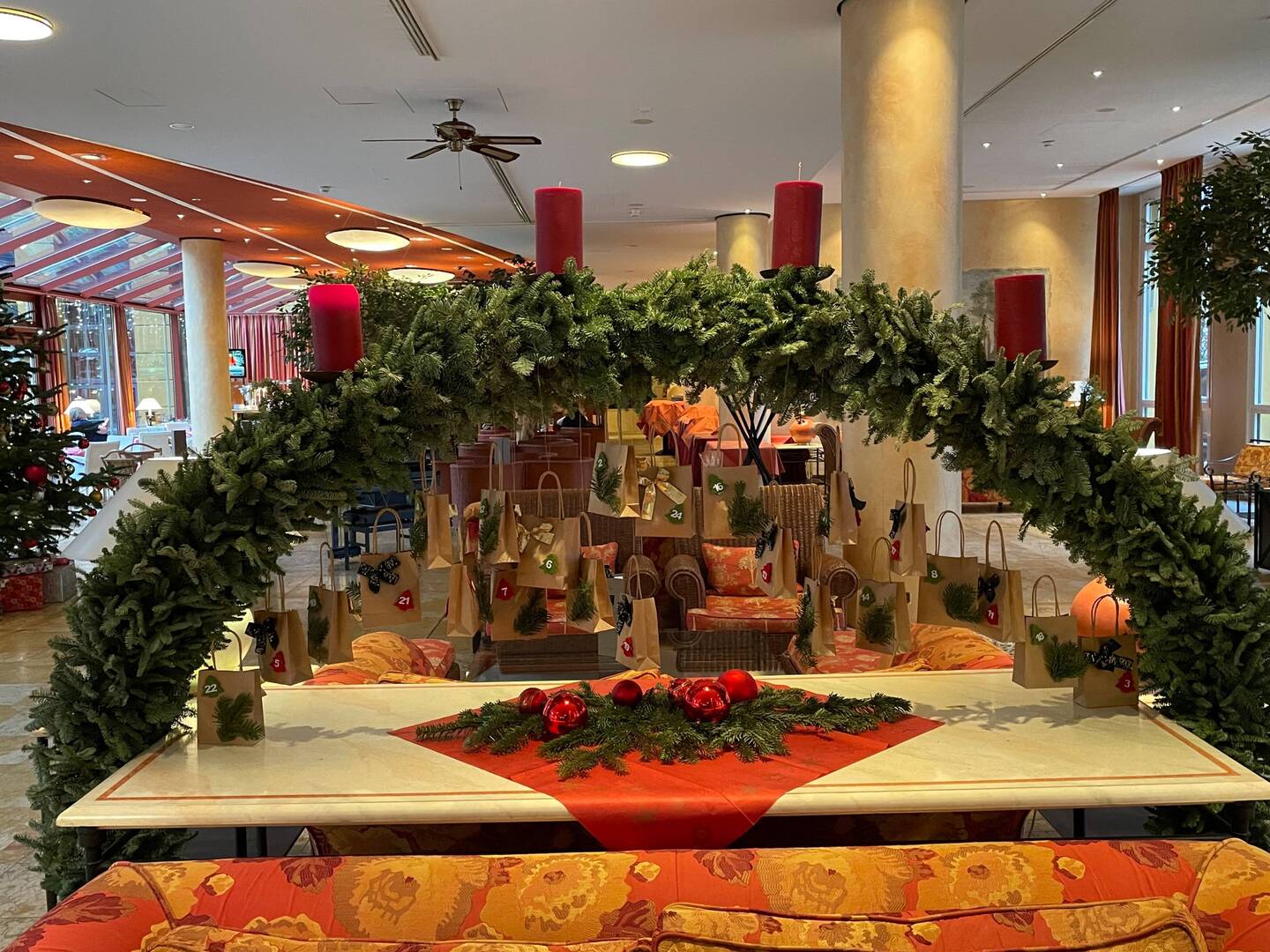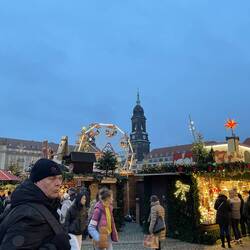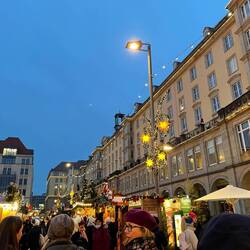December 2 - Dresden
 December 2, 2022 in Germany ⋅ ☁️ 0 °C
December 2, 2022 in Germany ⋅ ☁️ 0 °C
It was an early morning – up at 6:15 a.m., in the lobby at 6:45 a.m., taxi at 7:00 a.m., train station at 7:15 a.m. Angela met us there. The train left at 7:46 a.m. with typical German precision. We had paid the extra bit to have assigned seats. Well worth the expense.
Because we were going to be out of the hotel before the breakfast hours, the hotel graciously packed breakfast to go for us. They presented us with two huge carry bags. Each breakfast bag had a pretzel bun with cream cheese, another bun with ham and cheese, two little cakes (called madeleines), a clementine, an apple, and a banana. That should do us for lunch too!
The train got into Frankfurt on time. Angela figured out that we could access the lounge because we had first class tickets. There was free coffee/tea, croissants, cookies, mixed nuts, cookies, and giant pretzels. And we could pee for free. (1€ in the train station. 😢) Back to the train platforms. Again – assigned seating. Angela had to kick intruders out of some of our seats. We are now settled in for a couple of hours until we get to Dresden.
A bit out Dresden – I shamelessly pull information from Wikipedia. Dresden (population 585,000) is one of the most visited cities in Germany with 4.7 million overnight stays per year. Dresden's Striezelmarkt is one of the largest Christmas markets in Germany and is considered the first genuine Christmas market in the world.
The bombing of Dresden by the Royal Air Force (RAF) and the United States Army Air Forces (USAAF) between 13 and 15 February 1945 was controversial. On the night of 13–14 February 1945, 773 RAF Lancaster bombers dropped 1,181.6 tons of incendiary bombs and 1,477.7 tons of high explosive bombs, targeting the rail yards at the centre of the city. The inner city of Dresden was largely destroyed. Casualties numbered between 18,000 and 25,000.
Since German reunification in 1990, Dresden has again become a cultural, educational and political centre of Germany. The Dresden University of Technology is one of the 10 largest universities in Germany and part of the German Universities Excellence Initiative. The economy of Dresden and its agglomeration is one of the most dynamic in Germany and ranks first in Saxony. It is dominated by high-tech branches, often called "Silicon Saxony".
Its most prominent building is the Frauenkirche located at the Neumarkt. Built in the 18th century, the church was destroyed during World War II. The remaining ruins were left for 50 years as a war memorial, before being rebuilt between 1994 and 2005. Other famous landmarks include the Zwinger, the Semperoper and the Dresden Castle. Furthermore, the city is home to the renowned Dresden State Art Collections, originating from the collections of the Saxon electors in the 16th century.
We arrived just a few minutes behind schedule – we saw a lot of snow-covered fields along the way and wondered if we find snow in Dresden. Answer – no. We piled into a van taxi and arrived about 2:30 p.m. at the hotel. It is lovely! A bit of a hiccup – the suites only have one bed, so we arranged to have single beds added. We all agreed that we really only like sleeping with our respective husbands.
We set out about 3:30 p.m. for the markets. Dresden has the largest number of Christmas markets in the eastern part of the country and is one of the cities that are able to lay claim to the title of being the oldest seasonal event in Germany.
Certainly it is one of the most traditional, with many of the customs surrounding the main city market stemming from local industries like mining, woodworking and pottery.
A funny thing happened. A gentleman stopped us while we admiring a huge display in the lobby of the shopping galleria attached to the hotel. He said he liked to do one good deed per day, and for today, he wanted that good deed to be taking a group picture of us! We smiled - showing our teeth - as he instructed us and TA-DA - we had our team photo for the day!
The Striezelmarkt originally started back in the 15th century. The word 'Striezel' actually refers to a cake made at this time of year called a 'Stollen', which is also found in other parts of Germany, but in this area is reputed to represent the entrance to the mines in the nearby Erzgebirge range.
Another tradition stemming from the mining history is the Christmas arch - originally a metal but now usually a wooden arch which displays candles and figures. According to local folklore, this stems from the candles that the miners would hang from the entrance to the mine on the last working day before Christmas.
We found the Striezelmarkt about a 15-minute walk from the hotel. We were in the thick of it immediately. It’s Friday night so the crowds were out in force. We experienced the riot of sights and smells and sounds that I thought we would – gingerbread, sausage, chocolate, mulled wine, music, singing, lights, toy trains, decorated trees, sparkling ornaments, handmade items of every ilk, roasting chestnuts and so much more. We soon got our shopping mojo on and started our buying. No – no hints about what we’re bringing home!
We huddled a while later and decided we really needed to have dinner since lunch had been the ham and cheese bun on the train. Angela found a restaurant nearby. See the photos for the view we had while we dined - incredible. Most of us dove into big salads as the last few days have been heavy on the carbs. Fed and watered, we headed back out, this time to the market beside the Frauenkirche. (We will try to tour the church tomorrow in daylight.) Now, we really picked up speed on shopping. Now that we’ve got a fairly good handle on selection and prices, we’re more confident in our buying. We are heading back tomorrow morning for round two. Hopefully the crowds will be a little thinner during the early hours.
We agreed to meet for breakfast at 8:30 a.m. Let’s see if we make it this time!Read more





















Hi Everyone Amazing photos Maureen Love the crafts. I look forward each day to see where you go next Hello Vicky & Sheilagh (Loretta) [Loretta]
TravelerLoving the pics and reading about the Christmas traditions.